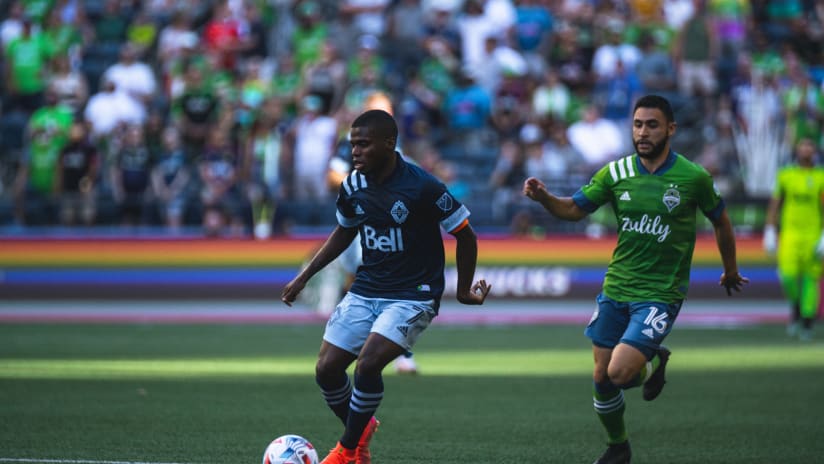Sometimes, there’s more to the beautiful game than meets the eye. Delve deeper with Analysts’ Corner, presented by EC Managed IT, a new blog featuring tactical insights from Whitecaps FC video analyst coach Andrew Peat, assistant video analyst Luke Summers, and Academy and assistant first team video analyst Andrew Foster.
Hey everyone! Luke Summers again with another installment of Analysts’ Corner. This time, I’ll be talking about attacking corners!
Corners and set pieces in general occur often within a game but you are forgiven for neglecting the finer workings to each situation. Corners are a messy collision of moving parts in a small area of the pitch and it can be difficult to work out what the plan is inside the box. In this article, I hope to bring you some insight into the planning and execution of corners in the professional game.
To start any attacking corner idea, the most important thing is to know your opposition. As I mentioned in my previous article (shameless plug), teams have very distinctive differences in their defensive shapes and you should alter your plans accordingly to your opposition. By studying your opposition, you can learn the weaknesses in their shape and/or individuals, and you can find the free space that the opposition gives up.
Let’s start at the origin of the corner: the delivery. The delivery is arguably the most important aspect to any corner as it sets the precedent for the whole play. The delivery trajectory, speed of the ball and final location are a vital in the “perfect” corner.
There are three basic delivery types: inswinging, outswinging, and short.
Inswinging corners
An inswinging corner has a trajectory that curls in towards the goal. The benefit here is that the ball will be moving in towards high-quality chance areas in and around the goal mouth. As a result, any contact will not only be close to the goal but also the delivery will be a more natural flight path to attack the ball for runners from the top of the box.
Inswinging deliveries are also very useful for being able to hit more than one target as the attackers are typically running towards the goal. This means that the delivery has the opportunity to stay in a dangerous area even if the main target is missed or the ball is deflected in some way.
Let’s take a look at Neymar’s goal below. Angel Di Maria uses his left foot from the right side of the pitch to deliver the ball. The ball curls in towards the goal and has enough power and accuracy to find Neymar in a 1v1 situation back post.
With inswinging deliveries, teams should be aware that there is a higher likelihood of the goalkeeper collecting the corner. And this could result in a quick transition, leaving the majority of your team in the attacking half of the pitch.
Outswinging corners
An outswinging corner has a trajectory of the ball that curls away from the goal. The benefit of this is that the ball moves away from the majority of the defenders and finds the spaces away from densely populated areas in the box. This allows affords the attackers the space to direct the ball towards goal. For this reason, it’s common that teams use outswinging corners to pick out a single target due to the flight of the ball.
Below is a clip of Liverpool. Trent Alexander-Arnold is a right-footed player taking the corner on the right side. His delivery curls away from goal, finding Jordan Henderson who has found time and space near the front zone and with a little help from his shoulder, Liverpool opens the scoring.
Like inswinging, outswinging corners come with limitations. The main one is that the trajectory typically puts the ball further away from goal and leads to less quality in your chance. As the ball is turning away from the goal, it might require the attacker to generate their own power to attack the ball due to the flight being typically away from the attacker.
Short corners
A short corner delivery is a short pass to either a player who is beside the taker or in front. Short corners can also be classed as a sort of routine and there are three main reasons why teams opt to use them: to shift the defending team’s positioning, to exploit overloads in wide areas, and to try and catch teams who have not set up quickly, like our U-15s did in the video you see below.
Short corners are limiting, however, as they do require a certain level of technical proficiency to make them work as often the attacking team is working in a reduced space and with pressure. They also come with a certain level of predictability should they be overused. Teams will have chance to prepare for the possibility of a short corner and be ready to adapt in the game. Short corners also mean that you don’t just adjust the point of attack for the defending team, you’re also adjusting the attack for your attackers, which can make it harder for players to adjust to create chances.
Now that we understand some of the basic delivery types, we can put all that we’ve learned into action. As I have mentioned previously, your set play design should be based on your opposition’s defensive structure. In this next section, I will give you two ways in which professional teams create goalscoring opportunities from the two defensive structures.
Let’s start with man-marking. Man-marking is the defensive system that matches defenders with attackers with the sole responsibility to defend the attacker and reduce space on opportunities. The first principle I would like to talk about it is picks or blocks.
‘Picks’ in football really came from the pick ‘n’ roll principle in basketball, where a teammate will block off a defender creating time and space typically for the shooter. Picks are probably the most noticeable inside the box but if done with subtlety it can be very difficult for the opposition to recognize what is about to happen until it’s too late, as we can see in this Chelsea example vs. Manchester United from a few years back.
Another concept is decoy movements. Decoy movements are the use of a number of your attackers to cause a big shift in the opposition’s defensive structure to allow another attacker to find space unmarked and with time.
Iceland does a fine job executing this content in the example below from 2017.
Now let’s move onto attacking against zonal marking – the structure that designates zones to players and not specific opposition players. They should defend the space that is in front or to the side of them and protect the goal at all costs.
One way to combat this type of structure is to create mismatches. Mismatches are common in zonal shapes as the blockers tend not to be your best defenders aerially. Rather, blockers’ role is to delay or slow attackers – failure to do so leaves your defensive line exposed.
Here’s an example from Liverpool this season.
The next concept is overloading a zone. This is when you look to create a numerical superiority in a defender’s zone, making it very hard for the defender(s) to overpower the numbers around them.
Here’s an example from FC Koln, in which four of their attackers overload the near post.
Teams are getting increasingly more astute in their defensive set-ups and commit a lot of time and effort into perfecting their ability to defend corner situations, which increases the importance on teams being able to develop and train well-executed routines and plays to create goalscoring opportunities.
I hope that I’ve been able to shed a little bit of light into how teams prepare for set plays in their games and maybe trigger some ideas of your own!




